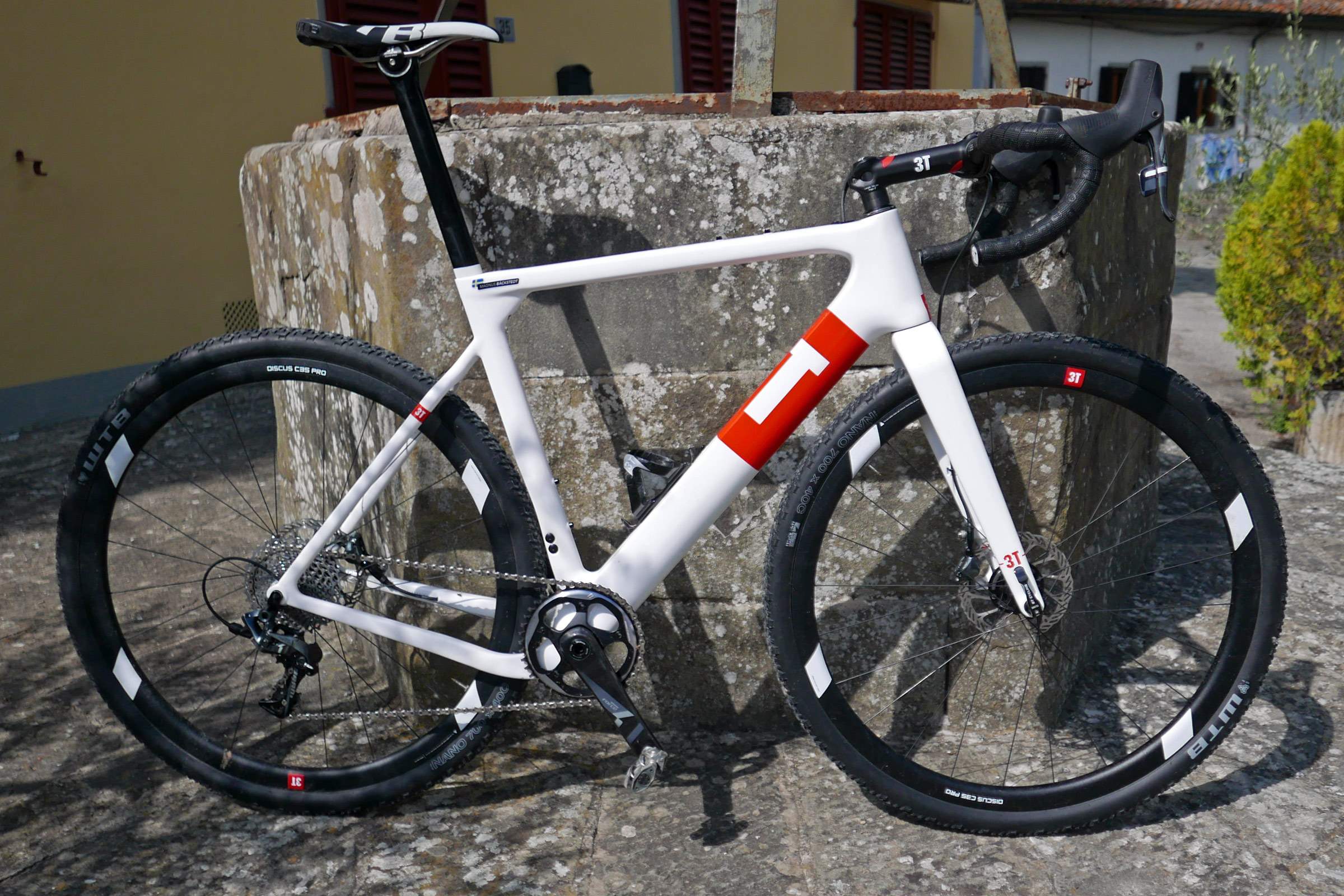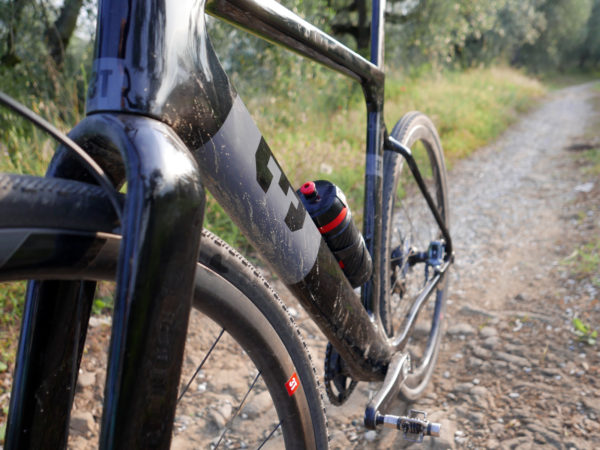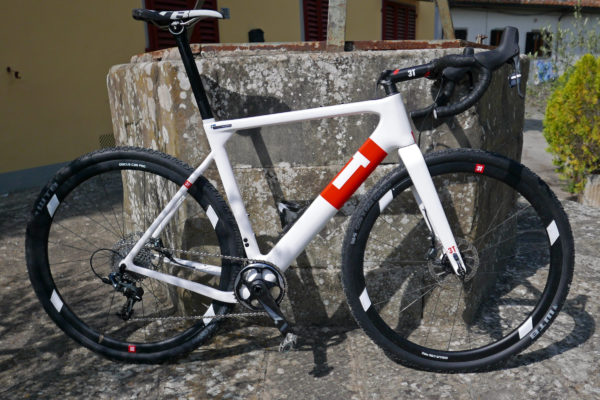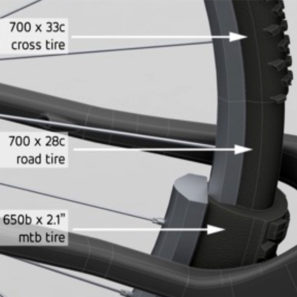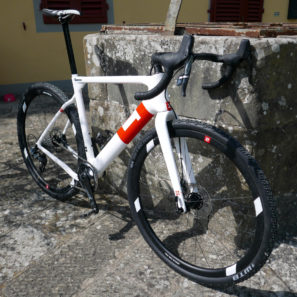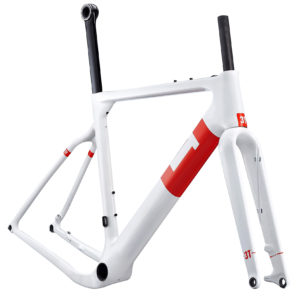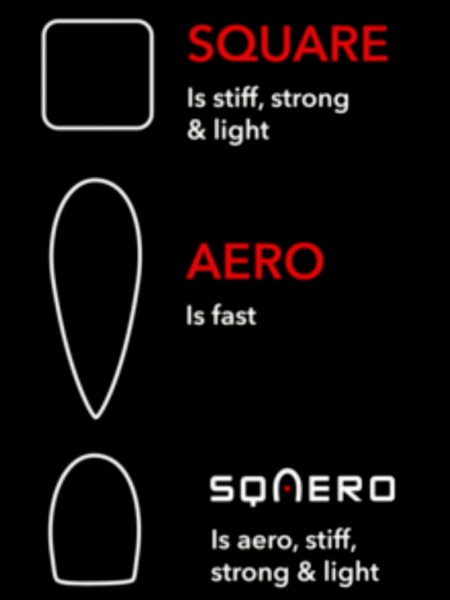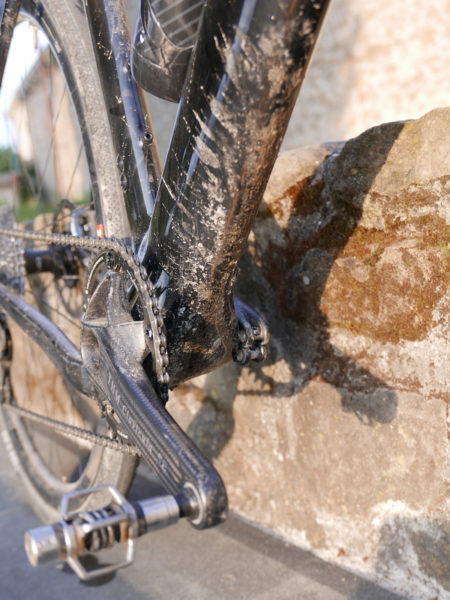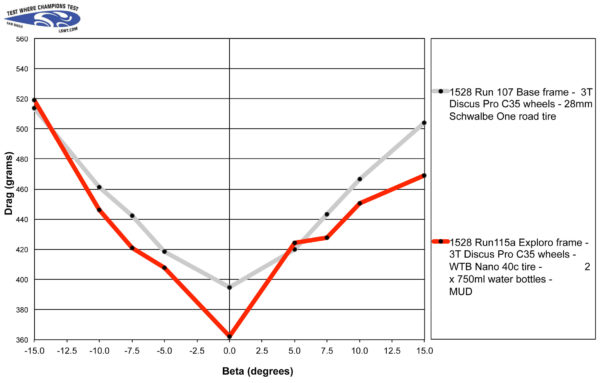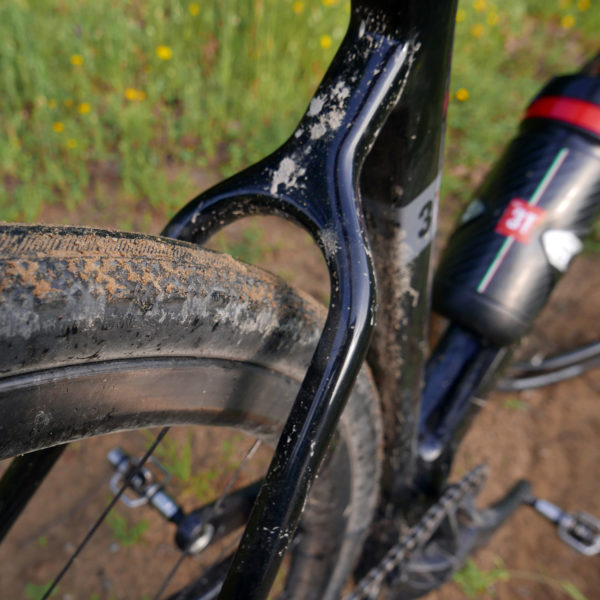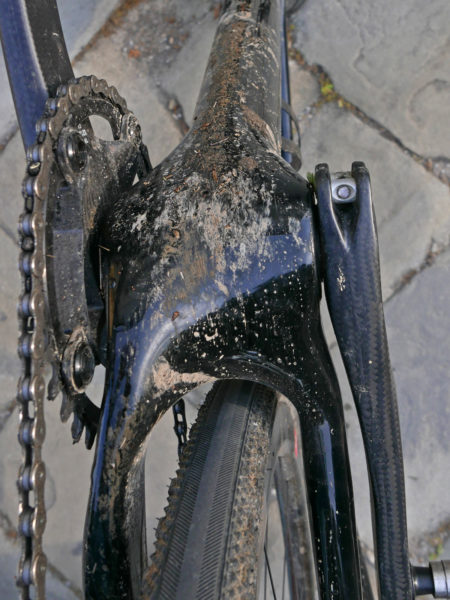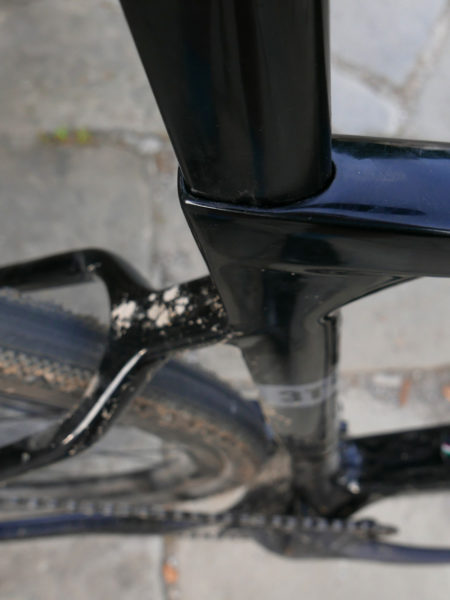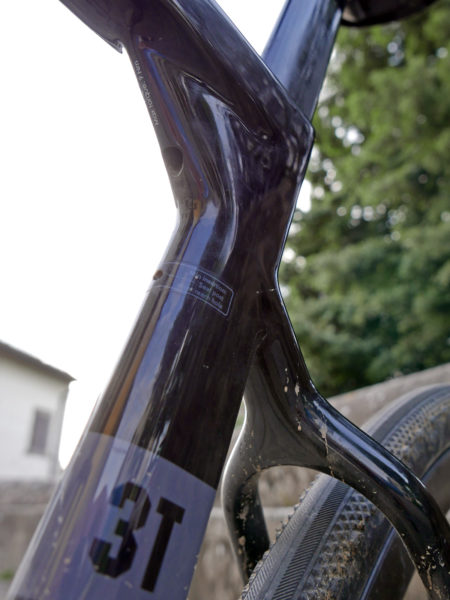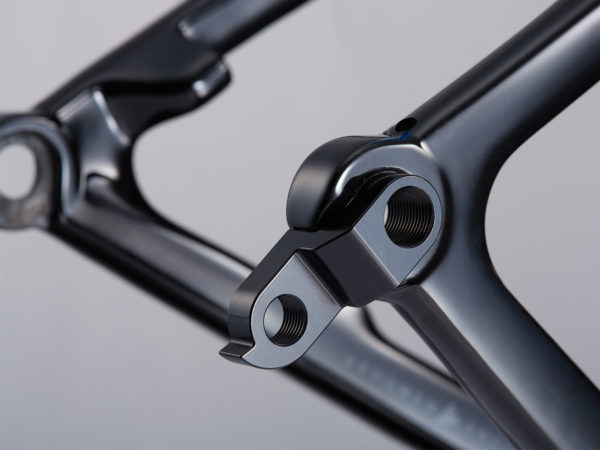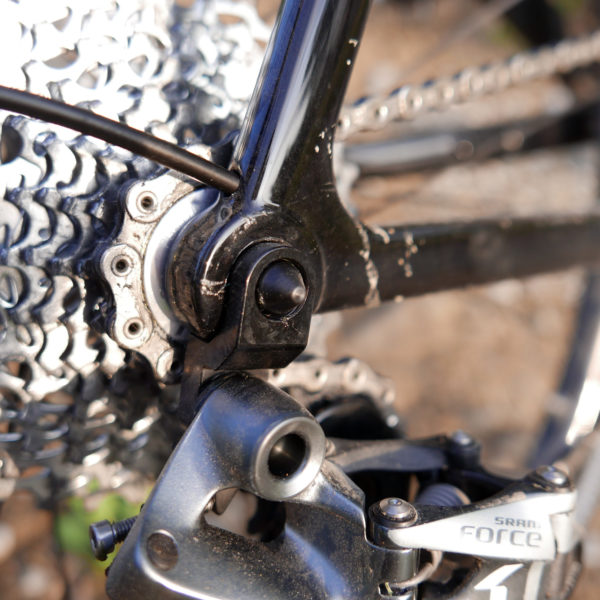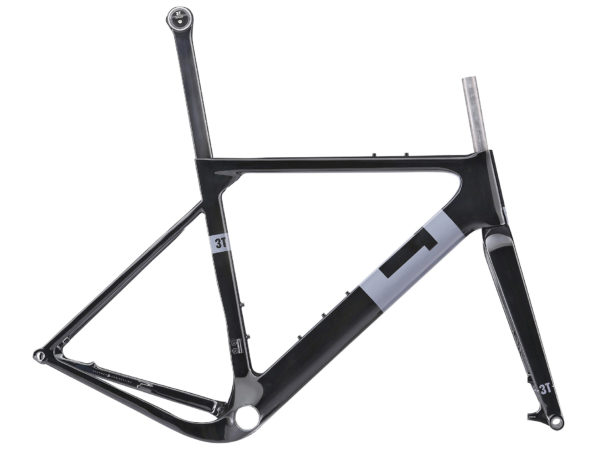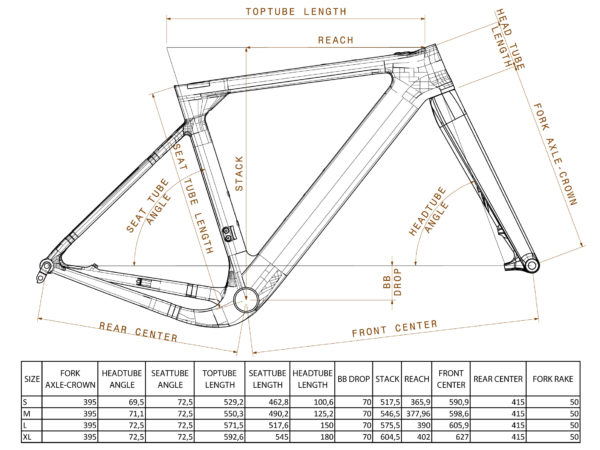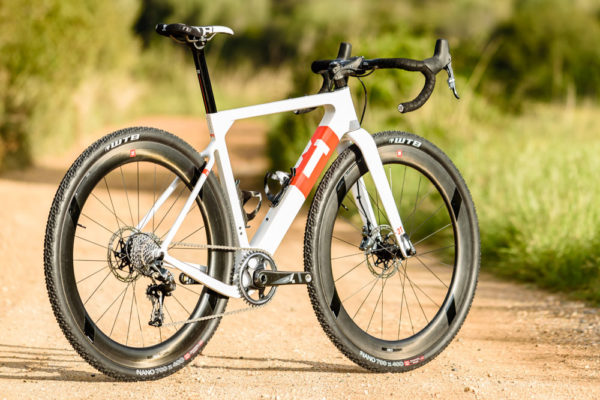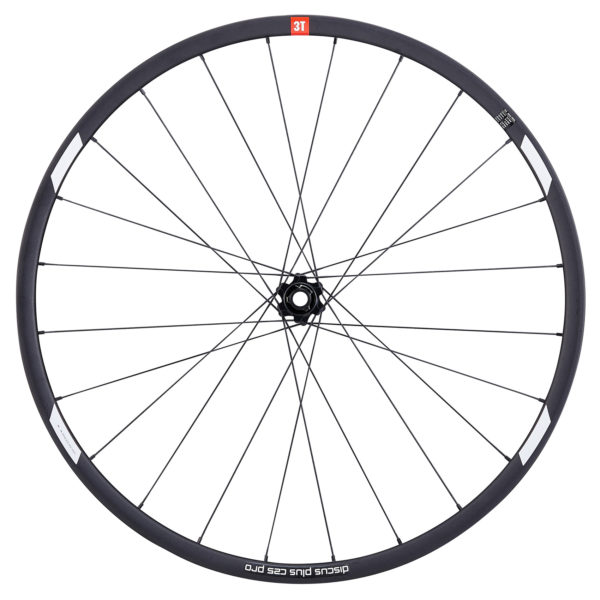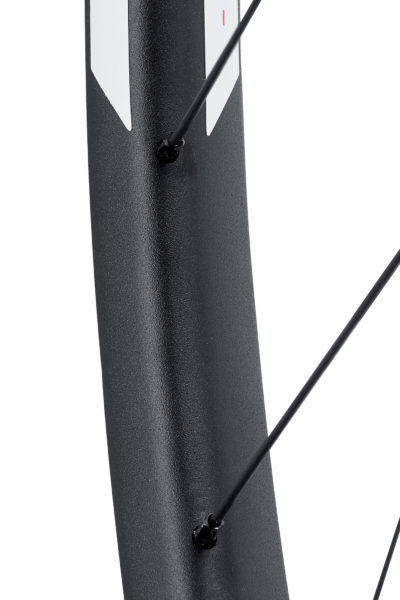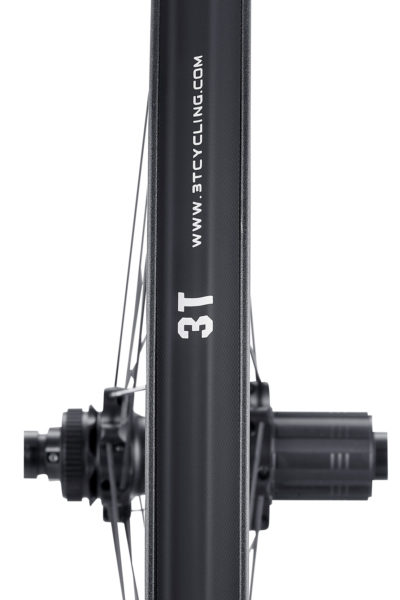It really shouldn’t be too big of a surprise to see a bike come out of the new 3T after Gerard Vroomen joined René Wiertz at the head of the company last year. Vroomen’s hand shaped innovative bike designs at both Cervélo and Open, and we clearly see some influence of that design progression in this new Exploro frame under the 3T brand.
Since its founding in 1961 3T has focused on making bikes more aero, so a gravel bike seems like a grand departure. But as long, gruelling gravel adventures have grown in popularity 3T thought, “why not see if it was possible to make gravel more aero as well?” 3T took the idea to San Diego’s low speed wind tunnel and found some interesting results adding in 700c x 40mm and 650b x 2.1 tires, and even some boundary air breaking mud. The concept turned into the idea “Go fast, slower.”
Check out our first look at the bike, full details, and even the new 650b+ wheels after the jump…
3T Exploro
We got the unique opportunity to join 3T in Tuscany this week for a preview of the new bike and some first rides ahead of a small group of European journalists. Besides getting to ride with fast guys from 3T’s team both in Italy and the US, we were joined by 3T ambassador Magnus Backstedt who has been riding on the new Exploro this spring. We snuck off with Maggy’s bike in the more affordable Team version to get a couple of shots at his setup, highlighted by a Force 1 Hydro group, 3T Discus C35 Pro carbon wheels and 40mm WTB Nano cross tires. All in all it was a pretty attainable spec.
Getting back to the heart of the frame, 3T developed the bike around a new GravelPlus concept. Gravel riders seem to want ever bigger tires and more volume, so 3T is happy to oblige. In the early days, all road cycling was gravel riding. And 3T is excited about this gravel 2.0 rebirth as it reconnects people with the essence of cycling: freedom and exploration. Plus, Gerard and René love it because they say they are slow and so it fits their personal riding style.
Since a 700c x 33mm tire and a 650b x 2.1” tire have essentially the same outer circumference, 3T designed the new Exploro to fit road, cyclocross, and even some 27.5 mountain bike tires. That lets the bike adapt to different styles of mixed surface riding depending on how much tire floatation and bump absorption you are looking for. With the 700c size 3T matches the frame to their Discus wheels, and for 650b they’ve added a new Discus Plus wheel option (details below).
The resulting bike can be set up from narrow file tread cross tires for smooth fast rolling riding, to supple 650b+ road tires for the ultimate cush ride, and even 27.5 XC mountain tires to make the bike more capable on some proper single track. But in the middle of that is the setup that most (from Magnus to us) would probably use, with high volume cross tires like WTB’s popular 40mm Nano(raptor) that make the bike ready to take on some techy trails, but a blast to hammer out the miles on endless dirt and gravel roads.
With the idea of getting areo on wide tires, Vroomen took a similar start as on previous designs, mixing square and airfoil shapes to get some of the best of both. But with the idea here of moving air off of and around fat tires 3T didn’t try to just go for a small frontal area. In fact they went the opposite way with a downtube that is a full 5cm/2” wide. But the leading edge of that tube (and others) gets a proper aero shape and a truncated tail – somewhat amusingly called Sqaero (yes, we are thinking Squoval 2.0 also) – that ends up actually sheltering a pair of water bottles pretty well. Not just the downtube, the headtube, seatstays, and proprietary seatpost also get Sqaero shapes.
We end up spending a lot of time out in the wind on good gravel adventure rides, so the idea of saving a few Watts is appreciated if realistic. 3T worked then on what they call RealFast aerodynamics, which amounted to testing the bike how people would really ride. That meant designing and testing the bike with pedals and bottles, and even mud (3D printed mud so it was replicable, and so LSWT didn’t kick them out) on the bike.
So that’s where testing at the San Diego LSWT came in, and running tests at a more realistic 20mph/32kmh (vs. the 30mph/48kmh that most bikes are tested at, but few riders ever achieve.) And in the end, putting the aero frame to the test with 40mm cross tires (and even the bottles and mud) it comes out faster than an equivalent round tube frame with 28mm road slicks.
The wider downtube works well to pick up the airflow coming off a wider cross or even mountain front tire and smooth it around a couple of water bottles, then past the more narrow 25mm (but deep) seat tube that leads air over the rear tire. At the slow speeds that comes to just 7W savings (or 24W at 30mph). And while that isn’t a lot, less energy required is always good, and the fact that it makes the fat knobby beat out a 28mm slick in the first place is pretty surprising.
The take away from the aero perspective is that with the Exploro you can match the speed of an endurance road bike, and when you hit the dirt and gravel you can drop everyone like a bad habit.
The Exploro gets a wide flat mono b-stay at the top of the seat stays that hits the seat tube below the seat cluster to help calm any chatter. That’s pretty important because the frame has such oversized downtube and asymmetric chainstays. The D-shaped ‘Charlie Sqaero’ seatpost means that the bike won’t offer any other seatpost options for now, but it does use 3T’s elastomer-damped head that does a decent job of tuning out the buzz without feeling flexy. The post gets an integrated internal wedge clamp accessible from under the toptube with a 4mm allen. Its location means it won’t be very accessible for some short multi-tools which is a bit annoying, so keep in mind that you might have to find what tool works best for on the trail use (we’ll take a look at a few when we get a bike in to test this summer.) The seattube gets a small hole to check to make sure you have proper post extension (since the clamp sits lower in the frame) and is the excuse of why the post got a personified name, just so Vroomen could call this feature Checkpoint Charlie.
At first glance a weird feature of the bike is a new Hang Loose derailleur hanger. The hanger actually contains the threads of the rear 12mm thru-axle, so when you remove the rear axle the rear derailleur and hanger slide out of the frame as the wheel is removed. To be honest, it sounded like a stupid idea to me at first, but in practice it means that when you go to replace the wheel all you need to do is align the rotor and slide in the axle. Then you just slide in the hanger and spin the thru-axle to lock everything down. It’ll take a bit of getting used to, but it seems to have really made alignment and rear wheel install easier, without the rear derailleur pulling the wheel out of line before the axle is threaded in.
The Exploro gets fully internal routing with a modular cap behind the headtube. Placing everything there can make for a clean look, but will require more attention to keep it tidy. But the frame uses full length derailleur housing, so you do end up with a bit of flexibility and can push it inside. We’ve had issues on some carbon frames making a ton of noise with that housing whacking the inside of the tubes. 3T includes a noise-cancelling foam sleeve for the cable, which seems to work. In a few rides we haven’t had an issue yet, but it is worth keeping an eye on.
The Exploro will come in two monocoque carbon framesets. The white Team version that Magnus Backstedt was riding has a frame weight of 1150g and comes in 3T team white with red logos. Paired with a 15mm thru-axle 3T Luteus II Team fork and seatpost the Team frames will sell for $3000/3000€/£2400. The Exploro LTD trims weight back to 950g and gets matched to the LTD edition fork. Pricing for its frameset is $4200/4200€/£3300.
Size large frames in both versions are available now, with the S, M & XL coming by the start of August 2016. 3T was calling the £ pricing Prexit or pre-Brexit pricing since they have no idea what it will be if that happens in a couple weeks. Anyway you can lock in the Prexit pricing if you buy now. Complete bikes will not be on offer, and you can get ahold of one of the framesets through any regular 3T component retailer.
The Exploro has one of the fastest, most responsive rides you’ll likely find on a gravel bike. That’s thanks to a relatively steep head angle with a short 50mm of trail and super short 415mm chainstays. (That’s short for an endurance road bike; crazy short for gravel or cross.) That gives quick steering, but at the same time means that the bike won’t suffer from getting the front wheel knocked around by rocks and ruts as much a slacker bikes with a lot of trail. It also makes the bike no slouch when it hits smooth roads, and no similar bike can match the acceleration with such a short rear end.
The Exploro frames use a BB386Evo, and can run either 1x or double ring setups (although no eTap double when that comes around. The front derailleur battery gets in the way of the rear tire.) The frame is designed to use compact road cranks, and can run up to a max of a 36T inner, 50T outer ring or on a 1x a max of a 46T for SRAM offset rings or more ideally a 50T max for a flat ring like the WTC I was riding.
The bike uses post mount 160mm rotors front and rear. It also has adjustable accessory mounting bosses. Three downtube bottle bosses let you optimize cage placement for 1 or 2 bottle setups, and the toptube gets bento box mounting points.
We had a chance to ride the bike a couple of days on smooth gravel, and bit of the Tuscan strada bianca, plus super steep 30% pavé climbs, dirt roads, and even some rocky trail and singletrack. I rode the bike with WTB’s new 34mm Exposure semi-slick gravel tire and came away fairly impressed. The bike felt really fast on asphalt and smooth gravel, and went up the hills as quickly as I could turn the pedals. Unfortunately, the other 4 guys I rode with were riding the same bike, so I didn’t benefit from any aero advantage, but the stiffness seemed to shine on the punchy climbs. On rough gravel downhills the bike flew, although there and on a bit more technical singletrack it was clear that I wasn’t on a mountain bike. Combined with 3T’s Luteus II fork, the front end is stiff, and the techy descending required a loose grip on the var to let the bike do its thing.
3T sees gravel as an extension of road riding, and that’s something i can get behind. I am curious to get more time on the bike and will look to get a long term test bike in soon. So look for a full bike test probably at the end of the summer.
Discus Plus
As for the new Discus Plus wheels in 650b, I didn’t ride them myself, but they will be interesting to try out. They are a smaller diameter version of the current 700c Discus wheels and share the same flexible end cap hubs. They are designed for wider Road+ and now Gravel+ tires so get a new wider rim and more spoke offset. A C25 Pro version will use a 21mm deep aluminium rim with 24mm wide inside and 1640g. A second C30W Team version will add in a 28mm deep carbon rim that grows to 28mm internal and drops to 1600g. Pro wheels will be available in July for $900/900, and carbon Teams fro $1900/1900€ in August.
